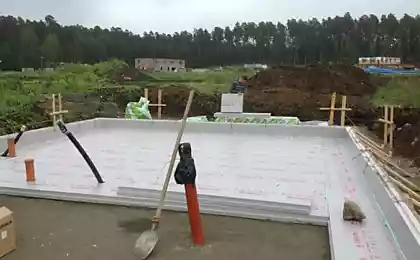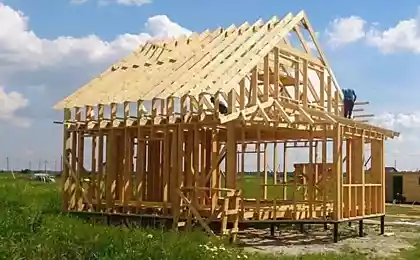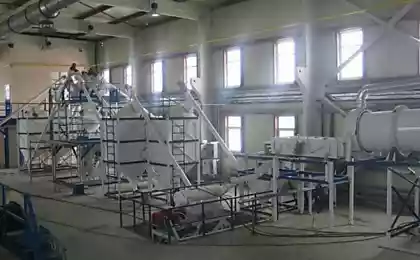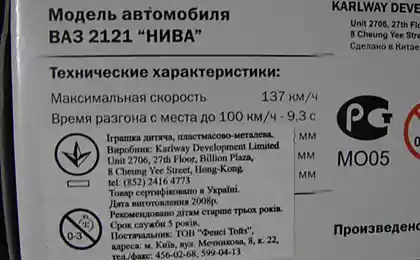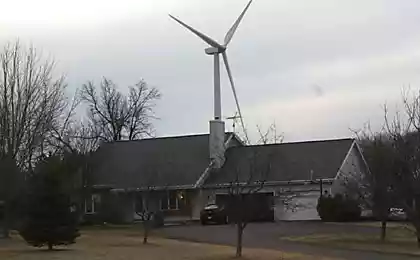737
Comparison of thermal conductivity of building materials - study the important figures
The construction of each object it is better to start with planning of the project and careful calculation of thermal parameters. Accurate data will allow you to obtain a table of thermal conductivity of building materials. The correct construction of buildings promotes optimal climatic parameters in the premises. And the table will help to choose the right raw material that will be used for construction.
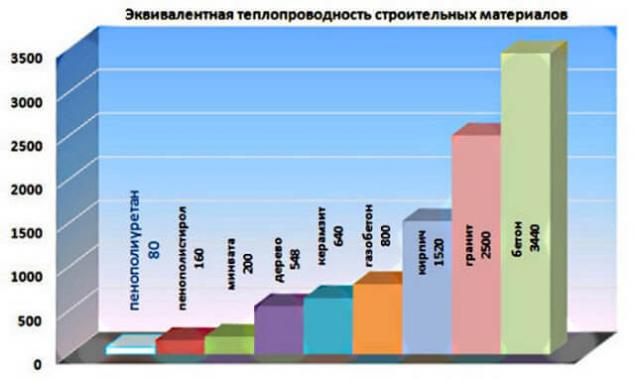
The purpose of the thermal conductivity
The thermal conductivity is a measure of heat transfer from the heated objects in the room to objects with lower temperature. The heat exchange process is performed until the temperature equalize. To refer to heat energy use a special coefficient of thermal conductivity of building materials. Table will help you see all the required values. Parameter indicates how much heat energy passes through a unit area per unit time. The greater the marking, the better the heat transfer. In the construction of buildings it is necessary to apply the material with a minimum value of thermal conductivity.

Thermal conductivity coefficient is such a value, which is equal to the amount of heat passing through the thickness meter of material per hour. The use of such characteristics is necessary for creating the best insulation. The thermal conductivity should be considered when selecting additional insulation structures.
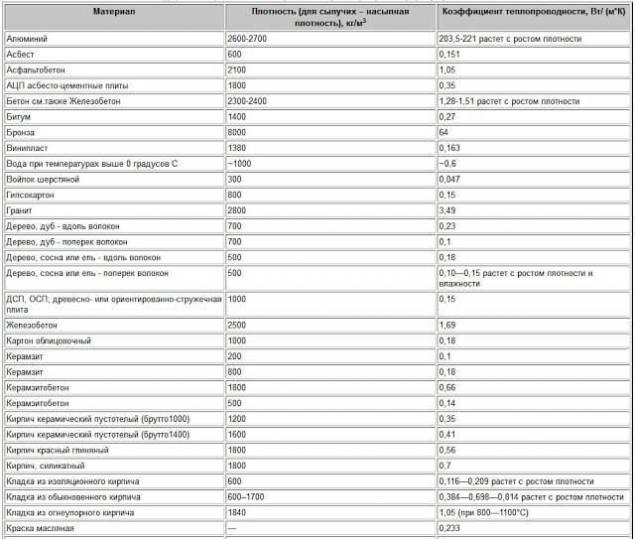
What affects the rate of heat conduction?
The thermal conductivity is determined by such factors:
• Porosity determines the heterogeneity of the structure. In one passage of heat through such materials, the cooling process is low;
• Increased density affecting the close contact between the particles, which contributes to more rapid heat transfer;
• High humidity increases this figure.

Using the values of the coefficient of thermal conductivity in practice.
The materials presented structural and insulating varieties. The first type has a larger conductivity values. They are used for construction of partitions, fencing and walls.
Using the table to determine the capabilities of their heat exchange. To this figure were low enough for normal indoor walls made of certain materials needs to be particularly thick. To avoid this, it is recommended to use additional insulating components.
The conductivity values for the finished buildings. The types of insulation.
When you create a project you need to consider all methods of heat loss. It can enter through the walls and roof and through the floors and doors. If you incorrectly do the calculations on the design, you'll have to be content with only the thermal energy generated from heating devices. Buildings constructed from standard raw materials: stone, brick or concrete need to insulate.
Additional insulation is held in frame buildings. While the wooden frame adds rigidity and insulation material is laid in the space between the uprights. In buildings of brick and cinder blocks insulation is on the outside of the structure.
When choosing insulation, you need to pay attention to such factors as the level of humidity, effect of elevated temperatures and the type of facility. Consider certain options of insulation structures:
• The rate of heat conduction affects the quality of thermal insulation process;
• Moisture absorption is of great importance for insulation of external elements;
• Thickness affects the reliability of insulation. Thin insulation helps to keep the usable area of the premises;
• Important Flammability. Quality raw material has the ability to-extinguishing;
• Thermostability displays the ability to withstand temperature changes;
• Environmental friendliness and safety;
• Soundproofing to protect against noise.
As insulation the following types:
• Mineral wool fire-resistant and environmentally friendly. Important features include low thermal conductivity;
• Styrofoam is a lightweight material with good insulating properties. It is easily installed and has moisture resistance. Recommended for use in non-residential buildings;
• Basalt wool unlike mineral is successful resistance to moisture;
• PENOPLEX resistant to moisture, high temperatures and fire. Has excellent conduction performance, easy to install and durable;
• Polyurethane foam is known for qualities such as flame resistance, good water repellency and high resistance;
• Extruded polystyrene in the production undergoes additional processing. Has a uniform structure;
• Heat insulation material is laid is a multi-layered insulation layer. The composition includes a polyethylene foam. The surface of the plate covered with foil to provide reflection.
For insulation can be applied to bulk raw material. This paper pellets or perlite. They are resistant to moisture and fire. And organic varieties can be considered fiber from wood, flax or cork. When choosing, pay special attention to indicators such as environmental friendliness and fire safety.
PLEASE NOTE! When designing insulation, it is important to consider the installation of the waterproofing layer. This will avoid high humidity and increase the resistance to heat transfer.
Table of thermal conductivity of building materials: characteristics of indicators.
Table of thermal conductivity of building materials includes various kinds of raw materials that are used in construction. Using this information, you can easily calculate the thickness of walls and amount of insulation.
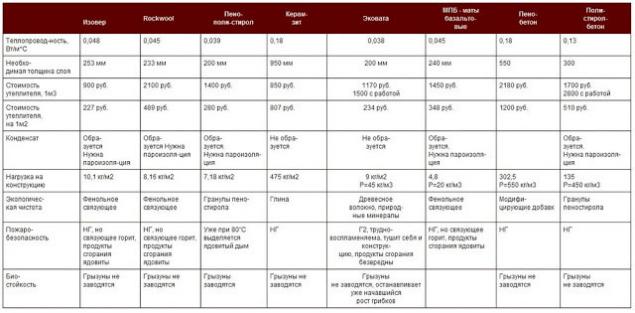
How to use a table of thermal conductivity of materials and insulation?
In the table, the heat resistance of materials are the most popular materials. By selecting a certain variant of thermal insulation, it is important to consider not only physical properties but also characteristics such as durability, price and ease of installation.
Did you know that the easiest way to do the installation penoizol and polyurethane foam. They are distributed on the surface in the form of foam. Such materials easily fill cavity constructions. When comparing the solid and foam versions, one must highlight that the foam does not form joints.
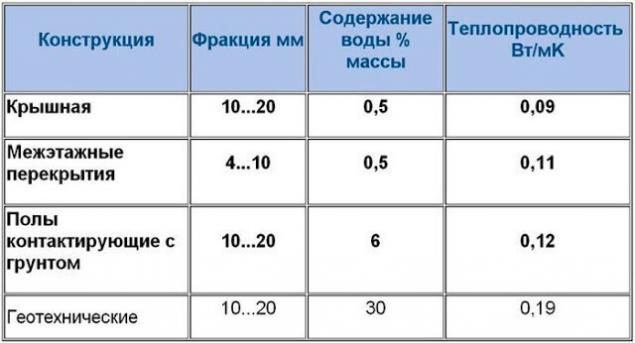
The values of heat transfer coefficients of the materials in the table.
When making the calculation to know the coefficient of heat transfer resistance. This value is the ratio of the temperatures on both sides to the amount of heat flow. To find teploproduktia certain walls and use a table of thermal conductivity.

All the calculations you can undertake yourself. For this purpose, the thickness of the insulator layer divided by the thermal conductivity. This value is often specified on the package, if it is isolated. The materials for the house are measured independently. This applies to thickness, and the coefficients can be found in special tables.
Coefficient of resistance helps to choose the specific type of insulation and thickness of the material layer. Information about permeability and density can be viewed in the table.
With proper use of tabular data you will be able to choose a quality material for the creation of a favorable microclimate in the room. published
P. S. And remember, only by changing their consumption — together we change the world! ©
Source: skrynka-pandory.blogspot.com/2017/02/blog-post_411.html?m=1

The purpose of the thermal conductivity
The thermal conductivity is a measure of heat transfer from the heated objects in the room to objects with lower temperature. The heat exchange process is performed until the temperature equalize. To refer to heat energy use a special coefficient of thermal conductivity of building materials. Table will help you see all the required values. Parameter indicates how much heat energy passes through a unit area per unit time. The greater the marking, the better the heat transfer. In the construction of buildings it is necessary to apply the material with a minimum value of thermal conductivity.

Thermal conductivity coefficient is such a value, which is equal to the amount of heat passing through the thickness meter of material per hour. The use of such characteristics is necessary for creating the best insulation. The thermal conductivity should be considered when selecting additional insulation structures.

What affects the rate of heat conduction?
The thermal conductivity is determined by such factors:
• Porosity determines the heterogeneity of the structure. In one passage of heat through such materials, the cooling process is low;
• Increased density affecting the close contact between the particles, which contributes to more rapid heat transfer;
• High humidity increases this figure.

Using the values of the coefficient of thermal conductivity in practice.
The materials presented structural and insulating varieties. The first type has a larger conductivity values. They are used for construction of partitions, fencing and walls.
Using the table to determine the capabilities of their heat exchange. To this figure were low enough for normal indoor walls made of certain materials needs to be particularly thick. To avoid this, it is recommended to use additional insulating components.
The conductivity values for the finished buildings. The types of insulation.
When you create a project you need to consider all methods of heat loss. It can enter through the walls and roof and through the floors and doors. If you incorrectly do the calculations on the design, you'll have to be content with only the thermal energy generated from heating devices. Buildings constructed from standard raw materials: stone, brick or concrete need to insulate.
Additional insulation is held in frame buildings. While the wooden frame adds rigidity and insulation material is laid in the space between the uprights. In buildings of brick and cinder blocks insulation is on the outside of the structure.
When choosing insulation, you need to pay attention to such factors as the level of humidity, effect of elevated temperatures and the type of facility. Consider certain options of insulation structures:
• The rate of heat conduction affects the quality of thermal insulation process;
• Moisture absorption is of great importance for insulation of external elements;
• Thickness affects the reliability of insulation. Thin insulation helps to keep the usable area of the premises;
• Important Flammability. Quality raw material has the ability to-extinguishing;
• Thermostability displays the ability to withstand temperature changes;
• Environmental friendliness and safety;
• Soundproofing to protect against noise.
As insulation the following types:
• Mineral wool fire-resistant and environmentally friendly. Important features include low thermal conductivity;
• Styrofoam is a lightweight material with good insulating properties. It is easily installed and has moisture resistance. Recommended for use in non-residential buildings;
• Basalt wool unlike mineral is successful resistance to moisture;
• PENOPLEX resistant to moisture, high temperatures and fire. Has excellent conduction performance, easy to install and durable;
• Polyurethane foam is known for qualities such as flame resistance, good water repellency and high resistance;
• Extruded polystyrene in the production undergoes additional processing. Has a uniform structure;
• Heat insulation material is laid is a multi-layered insulation layer. The composition includes a polyethylene foam. The surface of the plate covered with foil to provide reflection.
For insulation can be applied to bulk raw material. This paper pellets or perlite. They are resistant to moisture and fire. And organic varieties can be considered fiber from wood, flax or cork. When choosing, pay special attention to indicators such as environmental friendliness and fire safety.
PLEASE NOTE! When designing insulation, it is important to consider the installation of the waterproofing layer. This will avoid high humidity and increase the resistance to heat transfer.
Table of thermal conductivity of building materials: characteristics of indicators.
Table of thermal conductivity of building materials includes various kinds of raw materials that are used in construction. Using this information, you can easily calculate the thickness of walls and amount of insulation.

How to use a table of thermal conductivity of materials and insulation?
In the table, the heat resistance of materials are the most popular materials. By selecting a certain variant of thermal insulation, it is important to consider not only physical properties but also characteristics such as durability, price and ease of installation.
Did you know that the easiest way to do the installation penoizol and polyurethane foam. They are distributed on the surface in the form of foam. Such materials easily fill cavity constructions. When comparing the solid and foam versions, one must highlight that the foam does not form joints.

The values of heat transfer coefficients of the materials in the table.
When making the calculation to know the coefficient of heat transfer resistance. This value is the ratio of the temperatures on both sides to the amount of heat flow. To find teploproduktia certain walls and use a table of thermal conductivity.

All the calculations you can undertake yourself. For this purpose, the thickness of the insulator layer divided by the thermal conductivity. This value is often specified on the package, if it is isolated. The materials for the house are measured independently. This applies to thickness, and the coefficients can be found in special tables.
Coefficient of resistance helps to choose the specific type of insulation and thickness of the material layer. Information about permeability and density can be viewed in the table.
With proper use of tabular data you will be able to choose a quality material for the creation of a favorable microclimate in the room. published
P. S. And remember, only by changing their consumption — together we change the world! ©
Source: skrynka-pandory.blogspot.com/2017/02/blog-post_411.html?m=1










